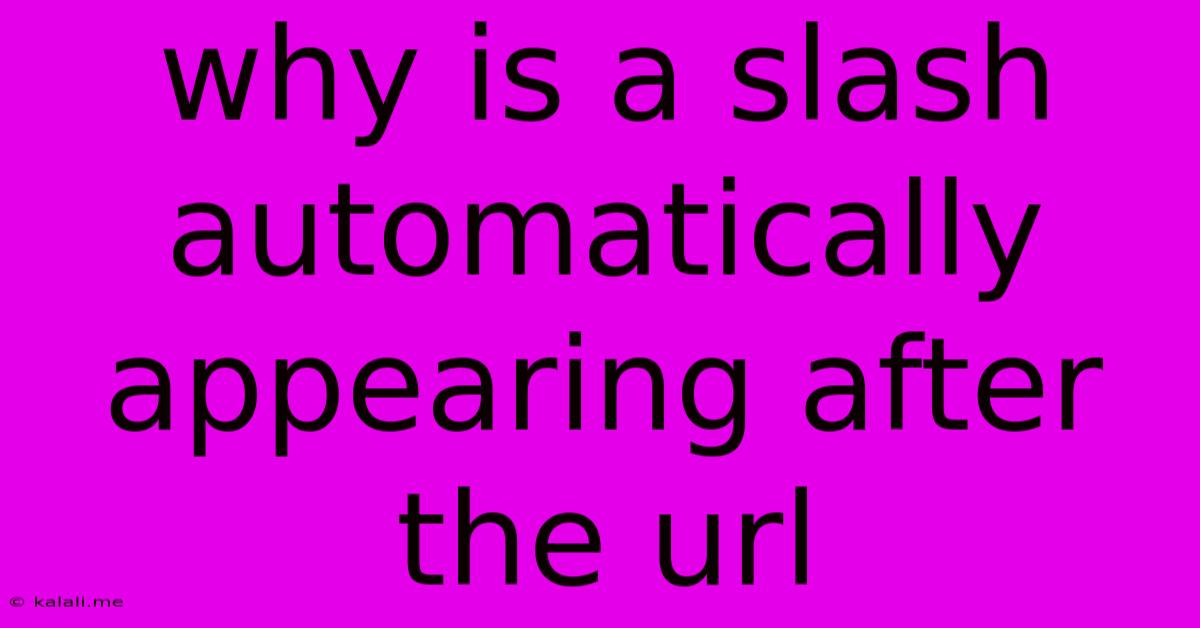Why Is A Slash Automatically Appearing After The Url
Kalali
Jun 01, 2025 · 3 min read

Table of Contents
Why is a Slash Automatically Appearing After My URL? Understanding URL Structure and Redirects
Have you ever noticed a forward slash / appearing at the end of your website's URL, even if you didn't type it? This seemingly insignificant character actually plays a crucial role in how your website functions and is often a source of confusion for website owners and developers. This article explains why this slash appears and the implications it has for SEO and user experience.
Understanding the Role of the Trailing Slash
The trailing slash / in a URL signifies the root directory of a website or a specific folder within that website. While it might seem redundant, it's a vital part of the URL structure and how web servers interpret requests. Think of it like a file path on your computer – /folder/file.html specifies the location of a file within a folder. Similarly, a URL with a trailing slash indicates that the request is for the contents of a directory, rather than a specific file.
Why Websites Use Trailing Slashes:
There are several reasons why a trailing slash is automatically added or preferred:
-
Consistency and Standardization: Many web developers and hosting platforms prioritize consistent URL structures. Using trailing slashes for directories helps maintain uniformity and improves code readability, especially in server-side scripting.
-
SEO Best Practices (Debated): While the impact of a trailing slash on SEO is debated, some argue that it can improve consistency in how search engines crawl and index your site. Having both
example.com/pageandexample.com/page/versions of a page can lead to duplicate content issues, which can negatively impact your rankings. A canonical URL tag can mitigate this. -
Server Configuration: Your web server's configuration might be set to automatically redirect requests without a trailing slash to the equivalent URL with a trailing slash, or vice-versa. This is common for directory listings or to prevent duplicate content. This redirection is usually handled using
.htaccessfiles (Apache) or similar mechanisms. -
User Experience: While not as significant, a consistent URL structure can contribute to a better user experience by preventing broken links or unexpected redirects.
When a Trailing Slash is Problematic:
While generally beneficial for consistency, a trailing slash can occasionally create issues:
-
Duplicate Content: If your website doesn't handle trailing slashes correctly, you might end up with duplicate content issues (e.g.,
example.com/pageandexample.com/page/pointing to the same content). This can confuse search engines and hurt your rankings. Using canonical URLs helps solve this. -
Broken Links: If you're not careful with trailing slashes in your links, you can accidentally create broken links, impacting your website's usability.
-
Redirect Loops: In some misconfigured setups, redirecting between URLs with and without trailing slashes can lead to infinite redirect loops, causing your website to become inaccessible.
Troubleshooting and Best Practices:
-
Check your server configuration: Examine your web server's configuration files (e.g.,
.htaccess) to see if any automatic redirects are in place. -
Use canonical URLs: Implement
<link rel="canonical">tags to specify the preferred version of your URLs (with or without trailing slashes). This helps search engines understand which version to index. -
Test your website: Thoroughly test your website to ensure that all URLs are accessible and handle trailing slashes consistently.
-
Maintain consistency: Choose a convention (with or without trailing slashes) and stick to it throughout your website.
By understanding the role of the trailing slash, you can build a more efficient and SEO-friendly website. Remember to address any potential issues arising from inconsistent handling of trailing slashes to ensure a seamless user experience and optimal search engine visibility.
Latest Posts
Latest Posts
-
Less Than Equal To In Latex
Jun 03, 2025
-
Why Did Jesus Change Peters Name
Jun 03, 2025
-
How To Fix Crack In Fiberglass Tub
Jun 03, 2025
-
Did Jesus Die On A Tree
Jun 03, 2025
-
When Do You Flip The Sign In Inequalities
Jun 03, 2025
Related Post
Thank you for visiting our website which covers about Why Is A Slash Automatically Appearing After The Url . We hope the information provided has been useful to you. Feel free to contact us if you have any questions or need further assistance. See you next time and don't miss to bookmark.